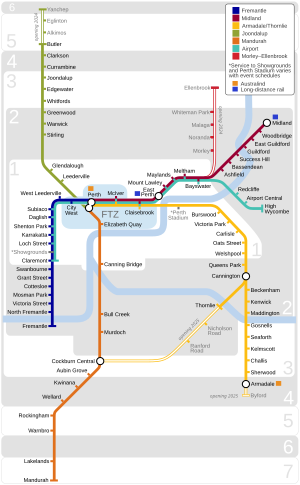Railways in Perth
| Overview | |||
|---|---|---|---|
| Owner | Public Transport Authority | ||
| Locale | Perth | ||
| Transit type | Commuter Rail | ||
| Number of lines | 7 | ||
| Number of stations | 70 (3 underground) | ||
| Annual ridership | 64.2 million (June 2015) | ||
| Operation | |||
| Began operation | 1998 | ||
| Operator(s) | Transperth | ||
| Technical | |||
| System length | 180.8 km (112.3 mi) | ||
| Track gauge | 1,067 mm (3 ft 6 in) | ||
|
|||
Transperth Trains is a division of Public Transport Authority of Western Australia. It is responsible for operating Perth’s urban passenger rail system, as part of the Transperth network.
The Fremantle to Guildford line commenced operating as a steam-powered service in March 1881, followed by the Perth to Armadale line in May 1889, and the Perth to Joondalup line (now Butler) in 1993 and the Perth to Mandurah line in December 2007. The Fremantle line service ceased in September 1979 but was reinstated in July 1983. Diesel trains were used on the rail network until the three lines then in service, the Armadale, Fremantle and Midland, were electrified in the early 1990s.
The first service with the A-series train was introduced in September 1991, with regular services beginning on the Armadale line on 7 October 1991. The Midland and Fremantle lines commenced service with the then-new A-series trains in December 1991.
The conversion from diesel to electric trains was accompanied by many upgrades to the rail network, such as upgrades to stations and tracks, and the cost of the undertaking was estimated at around $109 million.
The Northern Suburbs Transit System was the name given to the project to provide high-speed passenger rail services to the northern corridor of metropolitan Perth. To service the expanding northern suburbs, Joondalup line was built in the median of the Mitchell Freeway in the early 1990s, after several years of planning. The line was later extended to Currambine in 1993, to Clarkson in 2004 and Butler in 2014.
...
Wikipedia

